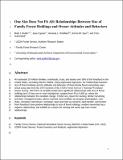Files in this item
One size does not fit all : relationships between size of family forest holdings and owner attitudes and behaviors
Item metadata
| dc.contributor.author | Butler, Brett J | |
| dc.contributor.author | Caputo, Jesse | |
| dc.contributor.author | Robillard, Amanda L | |
| dc.contributor.author | Sass, Emma M | |
| dc.contributor.author | Sutherland, Chris | |
| dc.date.accessioned | 2021-12-03T00:44:33Z | |
| dc.date.available | 2021-12-03T00:44:33Z | |
| dc.date.issued | 2021-01 | |
| dc.identifier | 272468345 | |
| dc.identifier | edff609b-5dbe-40ec-8633-9019e036caf0 | |
| dc.identifier | 85106551138 | |
| dc.identifier | 000651817800003 | |
| dc.identifier.citation | Butler , B J , Caputo , J , Robillard , A L , Sass , E M & Sutherland , C 2021 , ' One size does not fit all : relationships between size of family forest holdings and owner attitudes and behaviors ' , Journal of Forestry , vol. 119 , no. 1 , pp. 28-44 . https://doi.org/10.1093/jofore/fvaa045 | en |
| dc.identifier.issn | 0022-1201 | |
| dc.identifier.other | Bibtex: butler2021one | |
| dc.identifier.other | ORCID: /0000-0003-2073-1751/work/87404632 | |
| dc.identifier.uri | https://hdl.handle.net/10023/24474 | |
| dc.description | Funding for this project came from the USDA Forest Service, Forest Inventory and Analysis and State and Private Forestry, Cooperative Forestry programs. | en |
| dc.description.abstract | An estimated 10 million families, individuals, trusts, and estates own 39 percent of the forestland in the United States, excluding interior Alaska. Using segmented regression, the relationships between size of forest holdings and the attitudes and behaviors of these family forest ownerships were tested using data from the 2018 iteration of the USDA Forest Service's National Woodland Owner Survey. All 16 variables tested have significant relationships with size of forest holdings, and 13 have one or more breakpoints, ranging from 40 to 5,854 ac, where the relationships between the variables change. Timber as a reason for owning, timber harvesting activities, management plan, advice received, land certified, tax program participation, cost share, recreation, land tenure, recreation, taxes and heirs as concerns, land transfer, and income from forestland have positive relationships with size of forest holdings; resident ownership has a negative relationship; and wildlife as a reason for owning and owner age have mixed relationships. | |
| dc.format.extent | 17 | |
| dc.format.extent | 1076798 | |
| dc.language.iso | eng | |
| dc.relation.ispartof | Journal of Forestry | en |
| dc.subject | Family forest owners | en |
| dc.subject | National woodland Owner Survey (NWOS) | en |
| dc.subject | United States (US) | en |
| dc.subject | USDA Forest Service | en |
| dc.subject | Forest Inventory and Analysis | en |
| dc.subject | Segmented regression | en |
| dc.subject | SD Forestry | en |
| dc.subject | DAS | en |
| dc.subject | SDG 15 - Life on Land | en |
| dc.subject.lcc | SD | en |
| dc.title | One size does not fit all : relationships between size of family forest holdings and owner attitudes and behaviors | en |
| dc.type | Journal article | en |
| dc.contributor.institution | University of St Andrews. Statistics | en |
| dc.contributor.institution | University of St Andrews. Centre for Research into Ecological & Environmental Modelling | en |
| dc.identifier.doi | 10.1093/jofore/fvaa045 | |
| dc.description.status | Peer reviewed | en |
| dc.date.embargoedUntil | 2021-12-03 |
This item appears in the following Collection(s)
Items in the St Andrews Research Repository are protected by copyright, with all rights reserved, unless otherwise indicated.

